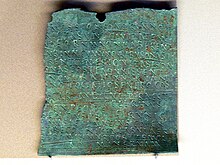Cohors V Bracaraugustanorum

The Cohors V Bracaraugustanorum ("5th cohort from Bracara Augusta ") was a Roman auxiliary force that served in Germania and in Rhaetian border fortifications until the Limes fall around 260 AD .
The troops were raised in the Hispanic province of Lusitania in the 1st century AD and initially transferred to a previously unknown location in Germania. This emerges from the grave inscription found on the Via Ostiensis near Rome by her then commander, the Cohort Prefect Marcus Stlaccius Coranus . Since the inscription only indicates Germania as the stationing area , the officer was on duty there before the official establishment of the two provinces Germania superior and Germania inferior . Research assumes that the two Germaniae - after examining military diplomas - were founded between September 82 and October 90 AD, probably around the year 85. Marcus Stlaccius Coranus therefore had his service with the Cohors V Bracaraugustanorum at the latest in served in the first years of the reign of Emperor Domitian (81–96).
At the latest since it was mentioned on a military diploma of May 13, 86 AD, the cohort was in the province of Raetia , where it is also attested in the Weißenburg military diploma of June 30, 107 and two diplomas from the year 116. Its original location could have been Gnotzheim Castle (Castra Mediana) , which existed at that time as a wood-earth facility . The unit located in Gnotzheim was certainly subject to the number stationed in the Unterschwaningen fort .
The Cohors V Bracaraugustanorum in the Künzing fort (Castra Quintana) is documented around the middle of the 2nd century . There it replaced the Cohors III Thracum civium Romanorum equitata to torquata , which moved into the Gnotzheim fort around 135 or a little later and managed the stone extension of the garrison there until 144. The Cohors V Bracaraugustanorum probably built the stone fort at their new location between 140 and 150 AD almost at the same time.
In 1996 a military diploma from AD 160 was discovered in Künzing. It mentions the then commander of the Cohors V Bracaraugustanorum , Iulius Celerinus , when the soldier Victor, son of Sendusis from the people of the Celtic Runicats, who lived in the Rhaetian-Vindelican area, and his wife Prima received Roman citizenship after 25 years of service . The 5th cohort obviously gave Quintana his name: Castra quintana = fort of the "fifth".
In the course of the collapse of the Limes defense, Künzing was completely burned down by 259/260 AD at the latest and had to be abandoned. At that time, the Cohors V Bracaraugustanorum will also have left their garrison if they did not go under during an Alemannic invasion .
See also
literature
- Werner Eck , Andreas Pangerl: Titus Flavius Norbanus, praefectus praetorio Domitians, as governor of Rhaetia in a new military diploma. In: Journal of Papyrology and Epigraphy . Vol. 163, 2007, pp. 239-251.
- Nicole Lambert, Jörg Scheuerbrandt: The military diploma. Source on the Roman army and documents (= documents from the Limes Museum Aalen 55). Konrad Theiss Verlag, Stuttgart 2002, ISBN 3-8062-1726-2 .
Individual evidence
- ↑ CIL 6,3539 .
- ^ Eck, Pangerl: Titus Flavius Norbanus. 2007, p. 247.
- ↑ Armin Becker : Rome and the chats (= sources and research on Hessian history 88). Self-published by the Hessian Historical Commission, Darmstadt / Marburg 1992, ISBN 3-88443-177-3 , p. 299 (also: Marburg, Univ., Diss., 1991/92).
- ↑ Werner Eck, Andreas Pangerl: Sex. Iulius Frontinus as a legate of the Lower Germanic army. To new military diplomas in the Germanic provinces . In: Journal of Papyrology and Epigraphy. Vol. 143, 2003, pp. 205-219, here pp. 206-207.
- ^ Eck, Pangerl: Titus Flavius Norbanus. 2007, pp. 239-251 ( AE 2007, 1782 ).
- ↑ CIL 16, 55 .
- ↑ Lambert, Scheuerbrandt: The military diploma. 2002, p. 55.
- ^ Eck, Pangerl: Titus Flavius Norbanus. 2007, p. 245.
- ^ Thomas Fischer , Günter Ulbert : The Limes in Bavaria. From Dinkelsbühl to Eining. Theiss, Stuttgart 1983, ISBN 3-806-20351-2 , p. 71.
- ↑ a b Dietwulf Baatz : The Roman Limes. Archaeological excursions between the Rhine and the Danube. 3rd, revised edition. Mann, Berlin 1993, ISBN 3-7861-1701-2 , p. 332.
- ↑ AE 2000, 1139 .
- ↑ Thomas Fischer, Riedmeier-Fischer: The Roman Limes in Bavaria. Verlag Friedrich Pustet, Regensburg 2008, ISBN 978-3-7917-2120-0 , p. 180.